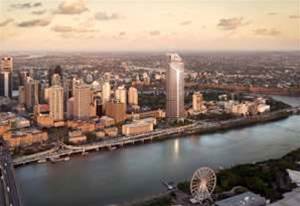The Queensland Government will use the ICT environment underpinning its new landmark tower in Brisbane as for wider business transformation as it begins to deliver its “ICT-as-a-service” mandate.

The $653 million 1 William St skyscraper, currently under construction in Brisbane, will house 4500 Queensland government employees as well as 1000 private sector workers once it is completed in late 2016.
The state government has previously encouraged those agencies moving into the building to take up a new-world approach to their IT architecture - specifically one able to support always online, anywhere and any device access to government data and applications.
An IT blueprint released in May encouraged agencies to support hot desking and BYOD models of working, as well as a shift towards cloud computing and 'ICT-as-a-service', in alignment with the 2013 Commission of Audit and the state’s subsequent ICT strategy.
It today approached the market for a prime ICT service integrator to provide common services to 1 William St, which will need to be offered in accordance with the cloud-based policy demands.
The Department of Science, IT, Innovation and the Arts (DSITIA) expects the underpinning IT environment to lead transformational change in the wider public sector, specifically by demonstrating new ways of working, such as activity-based working and collaboration between the public and private sectors.
"The government's vision for 1WS is to be a showpiece for a building of the future, one that is 'modern, innovative and designed for a creative and adaptable workplace'," DSITIA stated in tender documents.
"1WS also presents an opportunity for the government to begin implementing an improved ICT service delivery approach."
DSITIA expects that the new delivery model will allow agencies to:
- scale costs up and down based on need without being constrained by assets,
- increase standardisation of IT infrastructure across government and reduce duplication,
- allow for one procurement instead of duplicated processes for individual agencies, and
- provide common technologies for numerous agencies needing to invest in the infrastructure.
The solutions will need to comply with the US National Institute of Standards and Technology (NIST) defined cloud computing characteristics, and allow for rapid elasticity, resource pooling, on demand self service, and be evergreen, among other provisos.
The Queensland Government in May became the first Australian government to require its agencies to consider cloud-based solutions as the default option in any new IT procurements.
For 1 William St, the state is specifically looking for commercial, off-the-shelf services in the categories of core services (wired and wireless network, printing and imaging, video conferencing, collaboration and room booking); optional services such as desktop as a service and voice-over-IP; and professional services and service management, including support, maintenance and integration.
A federated identity and management solution will underpin the new-look ICT environment to allow multi-agency access to the services on offer, DSITIA said.
The federated identity solution will cover web-based room booking systems, visitor registration systems, and collaboration software, among other applications.
Queensland state agencies are expected to move into the landmark tower in late 2016. The 120,000m2 facility will contain 41 levels and three basements and will house the state’s premier, ministers and their immediate staff along with private sector tenants.


.png&h=140&w=231&c=1&s=0)



 iTnews Executive Retreat - Security Leaders Edition
iTnews Executive Retreat - Security Leaders Edition












_(1).jpg&h=140&w=231&c=1&s=0)



